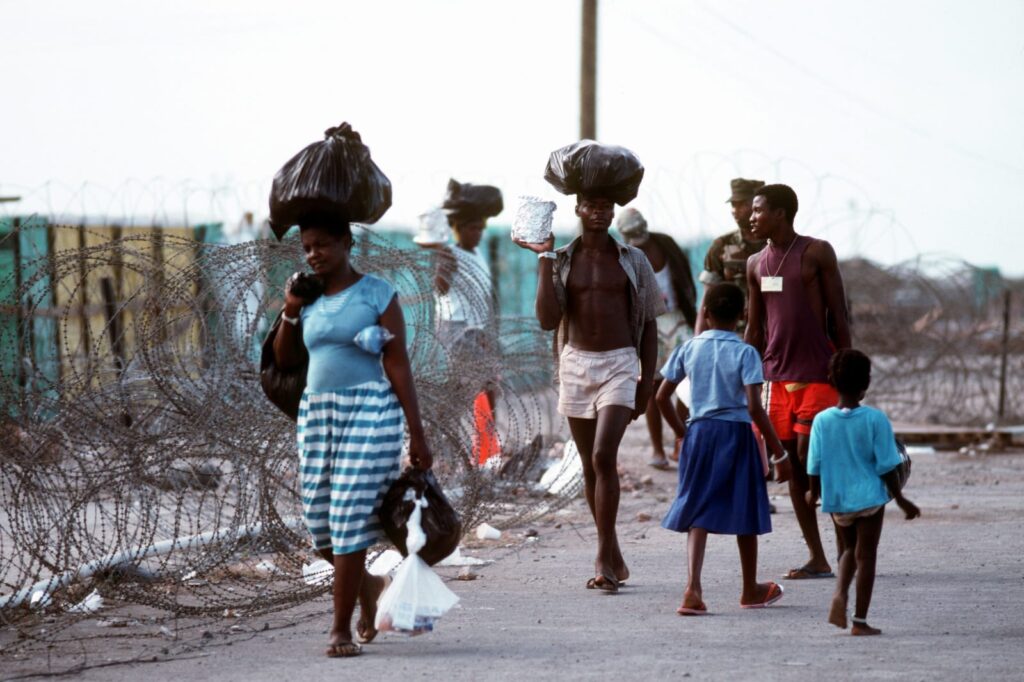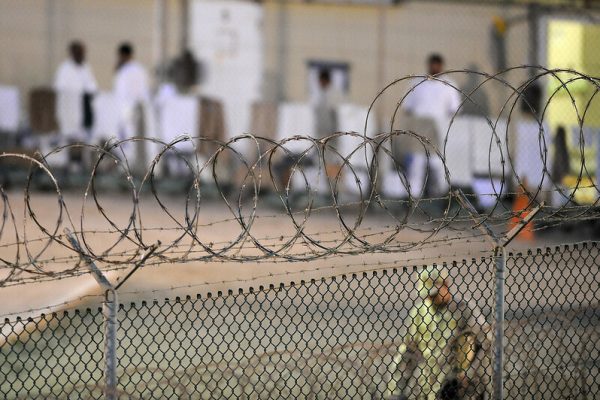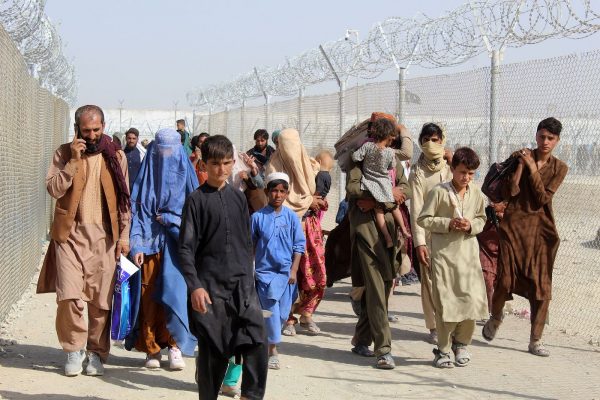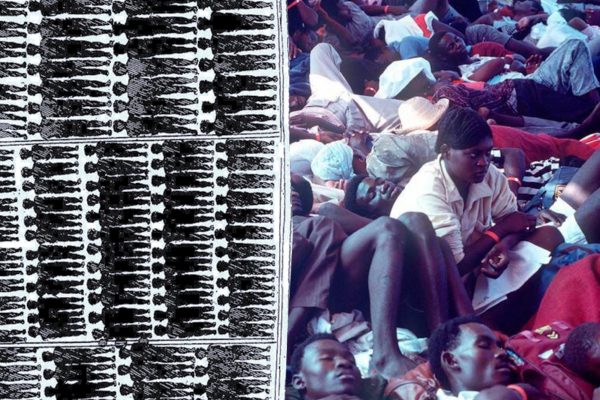When photos of mounted U.S. Customs and Border Protection (CBP) agents chasing down Haitians in Del Rio, Texas, emerged last month, the public outcry was immediate. In the most iconic of the images taken by photographer Paul Ratje, what looks to be a white border agent, his face locked in an expression of apparent anger, reaches down from his horse to grab the shirt of a Black Haitian immigrant. It was as if Ratje had captured the essence of what some of the more ardent critics of U.S. immigration policy had suspected for some time—that the events unfolding at the southern border were the most recent act in a much longer racist drama of settler colonial violence and enslavement. Vice President Kamala Harris acknowledged the power of this symbolism, remarking that the encounter “evoked images of some of the worst moments of our history where that kind of behavior has been used against the indigenous people of our country [and] has been used against African Americans during times of slavery.”
As the Biden administration worked to contain the fallout from the images, a twist in the story developed. Reporters from NBC took note of a Department of Homeland Security (DHS) bid solicitation for unarmed security contractors at the Migrant Operations Center at Guantánamo Bay. The announcement mentioned that to be successful, a contractor would need Creole speakers among its roster of guards. Leaning on that detail, NBC published a short piece asking whether Biden was reviving Trump-era proposals to relocate migrants from the border to the naval base. Forbes followed with the headline, “Biden Administration Eyes Guantánamo Bay to Hold Migrants,” and Business Insider ran a post alluding to a “proposed Guantanamo move.” Congresswoman Alexandria Ocasio Cortez responded to the NBC article via tweet, calling it “utterly shameful.”
The possibility of adding Guantánamo and all its connotations—torture, indefinite detention—to the mix of the unfolding border fiasco had caused the NBC story to morph from coverage of a suspicious government bid announcement to a revelation of a startling policy shift already in the making. But when asked about this prospect during an NPR interview, Department of Homeland Security Secretary Alejandro Mayorkas replied that “Guantánamo was a place that historically has been used to return individuals who are interdicted at sea. That is not applicable to the individuals whom we are encountering along the southern border.” With that denial, the Guantánamo angle dropped out of the larger discussion of the surge in Haitian asylum seekers arriving from Mexico.
The “nothing to see here” tone of Secretary Mayorkas’s response attempts to deflect criticism, but the denial divulges facts that are alarming in their own right. Even if the Biden administration was never planning to ship Haitians from Del Rio to Guantánamo, anyone following these events should be concerned about the mere existence of a Migrant Operations Center at Guantánamo Bay. What exactly is it, for one, and why is DHS seeking Creole-speaking contractors to run it now? Does Guantánamo and the detention of asylum seekers there really have nothing to do with the southern border? There is a menacing history of secrecy, abuse, and institutional forms that makes the answers to these questions more complicated than Secretary Mayorkas was letting on.
The story of detention at Guantánamo is inextricably tied to the remarkable sea journeys Haitians made across the northern Caribbean in the 1970s as they sought refuge in the United States from the repressive violence and economic devastation wrought by the dictatorships of François Duvalier and his son, Jean-Claude. Journalists’ accounts of these voyages often focus on the decrepit state of the vessels, the ruthlessness of the smugglers, and the wretchedness of those crammed aboard. One hears much less about Haiti’s master boat builders and the skilled Haitian captains who have long navigated complicated inter-island routes by compass, star, and memory. Nonetheless, it is true that seafarers who had once carried cargo on working sail vessels turned to transporting passengers northward in what were admittedly harrowing attempts to reach the United States. It is also true that as a result of these voyages, U.S. border control policies—and, eventually, border control policies across the globe—would never be the same.
Some of these Haitian migration vessels would travel hundreds of miles to sail right up onto the beaches of South Florida. Others, it turns out, would end up at Guantánamo Bay. For many of the Haitian captains, the coast of Cuba served as the key navigational reference they would use to guide them on their way to Miami. Following this route meant Haitians had to traverse the notoriously tumultuous waters of the Windward Passage—the “channel of wind” (kanal di van) in Haitian Kreyòl—between Cuba and Haiti, a crossing which often left vessels damaged and in need of repairs. While the town of Maisí on Cuba’s eastern tip commonly served this purpose nicely, some captains ended up further west in the protective waters of Guantánamo Bay.
According to a series of State Department cables—many of them divulged during litigation—at least 14 vessels carrying hundreds of passengers sailed into Guantánamo between 1972 and 1979. The first group to arrive was flown to Miami, although State Department officials, who derisively referred to them as the “12 Haitian apostles” and as “bums” in internal memos, would later push for their deportation. Other groups of Haitians who arrived at Guantánamo were provided assistance with repairs and offered supplies before being allowed to continue on their journey. This is almost impossible to imagine today given the criminalization of even the most basic acts of kindnesses by good Samaritans with regard to border crossers; leaving water for dehydrated migrants, for example, resulted in federal prosecutions during the Trump administration. In the 1970s, however, U.S. officials could resupply migrant vessels and even give them navigational advice, knowing full well they were carrying undocumented passengers to the Florida coast.
Lest this portrait appear too rosy, it is also necessary to consider the circumstances of those sailing in vessels ostensibly too damaged to continue onward from Guantánamo. Instead of heading back out to sea, they would be held at the base until a U.S. official could be dispatched to interview them. This was the beginning of Guantánamo’s role as a site for warehousing asylum seekers.
While the first group to arrive at the base was later flown to Miami before resettling in New York, 99 percent of the Haitians who were forced to undergo asylum interviews at Guantánamo thereafter were sent back to Haiti. Given that Haitians held at the base had no access to lawyers or, presumably, much of an opportunity to make their claims at all, this shouldn’t be surprising. More importantly, the speed with which the INS was able to return Haitians to Port-au-Prince became the key to Guantánamo’s later attractiveness as a detention site. To understand just how significant this high removal rate was, it is necessary to look at the very public drama that was simultaneously unfolding in the courtrooms of Miami.
Four months after the first Haitian vessel sailed into Guantánamo Bay, another arrived at Pompano Beach. More followed, showing up in the Keys, Port Everglades, and other sites up and down the South Florida coast. The INS was no more sympathetic to the claims of these Haitians than they were to those at Guantánamo, and they attempted to send virtually all of them back to Haiti after brief and cursory interviews. Remarkably, the government failed spectacularly to expel the vast majority of these Haitians thanks to the combined work of a dogged coalition of Haitian activists, a mix of progressive and radical lawyers, and a network of savvy advocates who trained the media’s eye on the plight of the Haitians while also helping federal courts see the injustice of the INS’s callous dismissiveness toward their asylum claims.
What emerged out of all of this was a stark dichotomy. On one side was Guantánamo, a place where the INS sent Haitians packing—quickly and in relative obscurity, out of sight of bothersome reporters and meddling lawyers. On the other side was South Florida, a place where the INS found itself mired in court battles, public accusations of racism, and, as a result, an almost complete breakdown of its deportation machinery with regard to Haitians.
This difference didn’t go unnoticed by the INS brass. In two memoranda, one apparently written by INS Deputy Commissioner Mario Noto in 1978, there is mention of a planned meeting to discuss “the feasibility of having the Coast Guard transport Haitians to Guantanamo Bay.” In other words, rather than wait for Haitian asylum seekers to sail up to the base’s piers, higher-ups at INS had begun to consider the possibility of just bringing Haitians directly to Guantánamo. Although the reasoning behind this proposal is not stated explicitly, it is patently obvious: it was easier to get rid of Haitians at the base. With that, the seeds of a more formal version of ad hoc asylum processing at Guantánamo were planted.
This Guantánamo policy option set the stage for a more ambitious use of the base as a site for migrant detention. But that is not what happened—not yet, anyway. Instead, government officials seized on a simpler option: they would begin and end with the Coast Guard. Detention, asylum interviewing, repatriation—all could be done from the deck of a ship operating beyond the prying eyes of journalists and attorneys.
During his first year in office, Ronald Reagan launched what was initially called Haitian Migrant Interdiction Operations (HMIO). In essence, the program was created to move asylum screening for Haitians offshore in an explicit effort to replicate what had taken place at Guantánamo—rapid and almost across-the-board repatriations—on U.S. Coast Guard vessels. Today the program is known as Alien Migrant Interdiction Operations (AMIO), the name change being the result of a 1989 rebranding designed, presumably, to make the program sound less Haitian-focused.
Over the past four decades, maritime migrant interdiction has become a standard border control tool. U.S Coast Guard vessels known as cutters interdict migrants in the Pacific and the Atlantic; the European Union and its member states do so in the Mediterranean and the Atlantic, and Australia does so in the Pacific, adding some devious permutations of its own creation. But back when HMIO was launched in 1981, this effort to push borders into the world’s oceans was new, and it marked a perverse paradigm shift.
On paper, interdiction was supposed to protect the rights of asylum seekers. Intercepted Haitians were to be interviewed and were to be brought to U.S. soil to pursue their asylum claims if there was an indication they might have a fear of persecution. The intent—again, on paper—was to meet U.S. commitments to international refugee law, but the numbers tell a different story.
During the first decade of interdiction (1981–1989), 21,461 Haitians were intercepted at sea, but only 6 were brought to U.S. soil to lodge formal requests for asylum—less than one tenth of 1 percent, during a period of dramatic tumult in Haiti that included the violent death spasms of the Duvalier dynasty, multiple coups, and an election-day massacre. One INS official I spoke with years later acknowledged that the interdiction officers carrying out interviews on the cutters “didn’t read [about] country conditions” and “didn’t know much about the law, even the definition, really, of refugees,” but their work was always “popular” with their bosses at the INS due to the small numbers of Haitians they cleared to come stateside.
Interdiction, then, had succeeded in what it had been designed to do—replicate the high repatriation rates achieved at Guantánamo during the prior decade. By 1990 the INS had already batted down an ill-formulated attack on the program’s legality and responded to some negative publicity surrounding a Lawyers Committee for Human Rights report on the program, but difficulties on the horizon would further entangle interdiction and Guantánamo as institutional forms.
When journalists talk about refugees at Guantánamo—something they rarely do to begin with—they often refer to the 1990s; the 1970s drop out entirely. With some exceptions, including critical reporting by journalist Carol Rosenberg, they also give the impression that Guantánamo ceased to exist as a site for refugee-processing after the mid-1990s. This is incorrect. Still, it is true that the base held the largest numbers of asylum seekers between 1991 and 1995—tens of thousands of Haitians, and, later, a mix of tens of thousands of Haitians and Cubans—and the existence of these camps laid the groundwork for the practice of holding asylum seekers at the base into the twenty-first century.
The story leading up to refugee processing at Guantánamo during the 1990s is also the story of a failed transition to democracy in Haiti. In December 1990, the Haitian people overwhelmingly elected Jean-Bertrand Aristide president in the country’s first free and fair elections, only to see the military oust him in September of the following year. When his supporters took to the streets in defiant protest, soldiers slaughtered them by the hundreds. An exodus by sea followed, and the U.S. interdiction program kicked into overdrive in response.
Interdicting Haitians at sea didn’t provide the easy solution for immigration officials that it had during the previous decade, or at least not at first. Certain that the interviews the INS was giving Haitians at sea were a sham, and armed with credible accounts of the open and highly visible brutality of the military toward supporters of the democratically elected government, advocates challenged the asylum procedures used aboard the cutters. A federal judge in Miami promptly intervened in November 1991, blocking returns to Haiti while the legal challenge proceeded. In response, a decision was made to bring large numbers of interdicted Haitians to the very site that had served as the model for interdiction itself—Guantánamo Bay. The purpose, just as with interdiction, was to stay offshore so that lawyers and courts could be kept out of the asylum process; the base would give the INS more breathing room to do just that while also preserving what the Department of Justice saw as the extra-territorial status of the whole endeavor—a status conferred by a jurisdictional peculiarity rooted in the terms of the base’s lease, which gave the United States control but not ultimate sovereignty over this small patch of Cuba.
The shift from interdiction at sea to what would eventually become large-scale migrant detention at Guantánamo was front-page news and the focus of national debate. For the American public of the 1990s, the Haitian refugee saga was what the crisis at the U.S. southern border is for the American public today. Ultimately the debate gave way to a U.S. military invasion of Haiti that would return Aristide and eventually stem the flow of asylum seekers. Still, even for those who followed the news of the refugee situation, the story of Guantánamo and the Haitian refugees seemed to come to an end once the last of the detainees were sent back to Port-au-Prince in 1995.
Of course, institutional forms that insulate executive power rarely just disappear; they tend to linger and have reverberating effects. Take interdiction, which was originally modeled after Guantánamo-style asylum processing during the 1970s and which later became the model for asylum processing at Guantánamo in the 1990s—what we might call Guantánamo 2.0. Today it is as robust as ever. The U.S. Supreme Court even set it on firmer legal ground in 1993 when it held that an extreme version of interdiction was lawful—a version in which no screening was offered whatsoever and every Haitian picked up was sent home. Europe and Australia have modeled their own, more recently adopted interdiction programs after the U.S. framework.
More subtle and more technical legal effects emerged from battles over the treatment of Haitian asylum seekers. The interview standard used during interdictions, for example, was further elaborated, formalized, and tested at Guantánamo, and then later became the governing standard of an expedited removal process implemented at U.S. points of entry—including along the southern border—starting in the late 1990s. And, of course, the fights over the power of U.S. courts to intervene in the detention of Haitian asylum seekers at Guantánamo in the 1990s (in particular those held in the base’s HIV quarantine camp) were front and center in the minds of the legal architects who worked to greenlight war on terror detention at Guantánamo following 9/11.
Even more directly, the practice of migrant detention at Guantánamo has also endured after the mid-1990s, though this fact often goes unrecognized in the press. Following the deportation of thousands after the conclusion of Operation Uphold Democracy in 1995, the INS did not simply revert to interviewing asylum seekers at sea as it had done the decade prior. Instead the United States launched what we might call Guantánamo asylum processing 3.0.
Version 3.0 works like this: if the U.S. Coast Guard stops a vessel and those aboard end up passing a “credible fear” interview, they are taken to Guantánamo for an additional interview to determine if they have a “well-founded fear of persecution,” a standard defined in international and U.S. law. If they pass that second screening, the U.S. State Department works to resettle them in third countries, like France or Australia. The deliberate aim is to destroy any perception that getting to Guantánamo is a way to get to the United States. To use the jargon of the State Department, the aim is to avoid “magnetizing” the base.
The facility used for Guantánamo asylum processing 3.0 is the Migrant Operations Center (MOC)—the very facility that people feared might be used to detain Haitians camped out in Del Rio, Texas, last month. The bid solicitation that sparked jolts of anxiety among refugee advocates and the Haitian community is just one of many that have been issued since at least 2002, when Wackenhut Corrections Corporation, now more widely known as the GEO Group, began providing guard services at the MOC.
Although the State Department and U.S. Immigration and Customs Enforcement (ICE) share responsibility for the MOC, ICE seems to be in charge of handling searches for guard and other contractor services. ICE also works diligently to keep the MOC under a veil of near total secrecy. When I traveled to Guantánamo in 2017, it was possible to visit facilities devoted to the base’s war on terror detention mission, but it was impossible to visit the MOC or even speak to anyone affiliated with it—although I did walk its tarp-cloaked perimeter on the leeward side of the bay. This atmosphere of carefully engineered concealment seems to have reigned for decades.
Since the mid-1990s, then, the United States has run a quasi-hidden migrant detention center at Guantánamo based on a longstanding model of giving Haitian asylum seekers as little procedural protections as possible before sending them back to Haiti. The public has very little understanding as to what goes on there, and that’s by design. We know that some refugees have resided on the base for years while they await resettlement, that some are able to work and move about during that time, and that others have been held in prison-like conditions of confinement. We know much less about what these asylum hearings actually consist of, and we have little insight into how those held there are treated. The Migrant Operations Center at Guantánamo Bay remains a black box.
Implicit in Secretary Mayorkas’s acknowledgment that Guantánamo’s Migrant Operations Center is open, just not for asylum seekers from the U.S.-Mexico border, is a sense that there is no ethical or legal quandary raised by the detention of potential refugees in mysterious conditions of near total secrecy so long as they are Haitians plucked from the sea rather than the land. At the very least, the nonchalant deflection of criticism suggests that the continued existence of the Migrant Operations Center is not expected to provoke outrage. This is not exceptional, Mayorkas seems to be saying: this is just how things are done.
There is danger here. Before Trump took office, I wrote about how some of the policy responses to Haitian migration had reappeared in frameworks for dealing with other asylum seekers at land borders. At the same time, I hypothesized it would be much harder to engineer the flexibility of interdiction and of Guantanamo 3.0 on the U.S.-Mexico border. So-called “metering,” the migrant protection protocols, asylum bans, and the use of “Title 42” have done much to achieve that very outcome, though these programs have been mired in litigation and their fate is uncertain. One hopes they will not endure as another new normal that mimics the extreme measures tested on Haitians for decades in the U.S. offshore borders of the Caribbean.
This situation becomes all the more disturbing when one thinks of the photographs of the mounted CBP agents in Del Rio. Would such powerful documentation of abuse have come to light if something equivalent had happened at sea or at Guantánamo? The legitimacy of interdiction and the Migrant Operations Center is premised upon the plausibility of a demand for trust amidst secrecy: we are being told, in effect, that there is no need to look behind the curtain. Yet in light of the history of U.S. mistreatment, demonization, and pathologization of Black Haitian asylum seekers—along with the arc of border policy experimentation that has been used to deal with them—such trust certainly has not been earned. In these rare moments when long normalized exceptions begin to resurface in public debate, we need to seize such disruptions to question, again, the legitimacy of what has too easily slipped from view.








